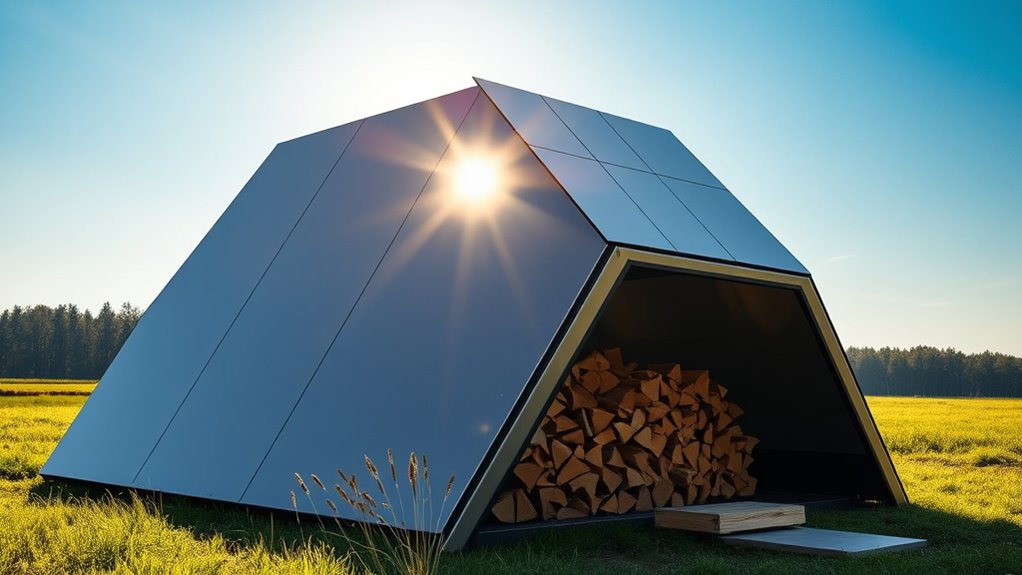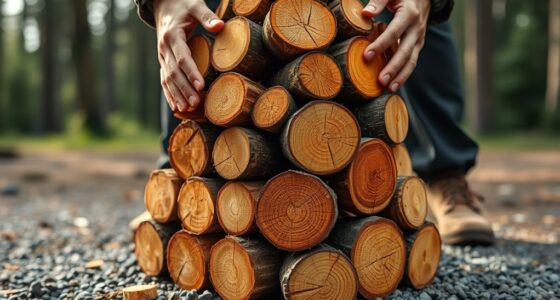To build a solar firewood kiln, start by finding a south-facing outdoor spot and use durable, weather-resistant materials. Incorporate transparent covers like glass or clear plastic to maximize sunlight exposure, and add insulation around the sides for heat retention. Using reflective surfaces or mirrors can boost sunlight, while including vents helps control humidity. Keeping these tips in mind will help you create an efficient, eco-friendly drying space—continue to explore for more detailed plans and ideas.
Key Takeaways
- Design the kiln with south-facing orientation and transparent covers to maximize sunlight exposure.
- Incorporate reflective surfaces or mirrors to direct additional sunlight into shaded areas.
- Use insulation and thermal mass materials to retain heat and maintain consistent drying temperatures.
- Include adjustable vents for airflow and humidity control during the drying process.
- Build with weather-resistant, durable materials for outdoor longevity and minimal maintenance.

A Solar Firewood Kiln offers an eco-friendly and cost-effective way to dry firewood using renewable solar energy. By harnessing the sun’s abundant power, you eliminate the need for traditional fossil-fuel-powered drying methods, reducing your carbon footprint while saving money on energy costs. The success of your solar kiln heavily depends on thoughtful kiln design, which involves optimizing how solar energy is captured, stored, and transferred to the firewood. When planning your kiln, focus on creating a structure that maximizes exposure to sunlight and minimizes heat loss. Typically, a well-designed solar kiln features a transparent or semi-transparent cover—like glass or clear plastic—that allows sunlight to penetrate and warm the interior. The design should also include insulation around the sides and back to retain heat and maintain consistent drying temperatures.
Your kiln’s orientation matters considerably; positioning it to face the sun for most of the day ensures maximum solar energy absorption. A south-facing setup in the northern hemisphere generally works best. Incorporate vents or adjustable openings to control airflow and humidity levels, which are critical for efficient drying. Good kiln design also considers airflow pathways, promoting natural convection that pulls moist air out and pulls dry, warm air in. This constant movement speeds up the drying process and prevents mold or decay. Additionally, understanding solar energy principles can help optimize your kiln’s efficiency and performance.
Using solar energy in your kiln design also involves integrating reflective surfaces or mirrors to direct additional sunlight into shaded areas, boosting overall heat gain. Consider adding a thermal mass, like black-painted metal or concrete inside the kiln, to absorb and radiate heat evenly across the drying chamber. This approach helps maintain consistent temperatures even when sunlight fluctuates. Another tip is to build your kiln with durable, weather-resistant materials to withstand outdoor conditions over time, reducing maintenance needs.
Finally, plan your kiln’s size based on how much firewood you want to dry at once. A larger kiln can handle more wood but requires more extensive solar collection and insulation. Smaller, well-insulated designs may suit backyard use and still provide efficient drying. With careful kiln design centered around ideal use of solar energy, you’ll create an effective, sustainable drying system that lowers your energy costs and minimizes environmental impact. Proper planning and attention to detail ensure your solar firewood kiln performs efficiently, providing you with well-dried firewood while promoting renewable energy use.
Frequently Asked Questions
How Much Does a Solar Firewood Kiln Typically Cost?
A solar firewood kiln typically costs between $1,500 and $4,000, depending on size, design, and materials. You should consider your budget considerations carefully, as more advanced features or larger capacities increase the overall cost. For an accurate cost estimation, plan for materials, potential labor, and any additional equipment. By evaluating your needs and budget, you can find a solar kiln that offers efficient firewood drying without overspending.
What Is the Average Drying Time for Firewood in a Solar Kiln?
You can expect firewood to dry in a solar kiln within 1 to 3 weeks, depending on moisture content and drying stages. Initially, the wood undergoes active drying, where moisture is rapidly lost, followed by a stabilization phase. Factors like wood thickness, initial moisture, and ambient conditions influence drying time. Regularly checking the moisture content helps guarantee your firewood reaches the ideal level for efficient burning.
Can Existing Firewood Drying Methods Be Integrated With Solar Kilns?
Yes, you can integrate traditional drying methods with solar kilns. Start by partially air-drying your firewood before placing it in the solar kiln for final curing. This hybrid approach speeds up drying time and reduces energy use. You might also stack logs in a way that maximizes airflow, combining traditional air-drying benefits with kiln efficiency. This integration helps guarantee your firewood is properly seasoned, ready for use, and saves time.
What Safety Precautions Are Necessary When Operating a Solar Firewood Kiln?
Think of operating your solar firewood kiln like steering a ship through calm waters; safety is your compass. Always wear protective gear like gloves and goggles to shield yourself from splinters or sparks. Keep a fire extinguisher nearby, and make certain your workspace is clear of flammable materials. Regularly check for fire hazards and stay vigilant during operation to prevent accidents and maintain safe, effective drying.
How Weather-Dependent Is the Kiln’s Efficiency?
Your solar firewood kiln’s efficiency is quite weather-dependent, mainly influenced by climate conditions and seasonal variation. Sunny, warm days boost solar heat, speeding up drying times, while cloudy or rainy weather reduces effectiveness. During winter, shorter daylight hours and lower sun angles can slow the process, so you might need extra time or supplemental heat sources. Monitoring weather patterns helps you optimize your kiln’s performance year-round.
Conclusion
Building a solar firewood kiln is like planting a seed—you’ll see it grow into a sustainable solution. With simple plans and clever tips, you can efficiently dry your firewood using the sun’s power. Just stay patient and persistent, and you’ll have a reliable way to prepare your wood all year round. Think of your kiln as a warm hug for your firewood, making every piece burn brighter and longer.









